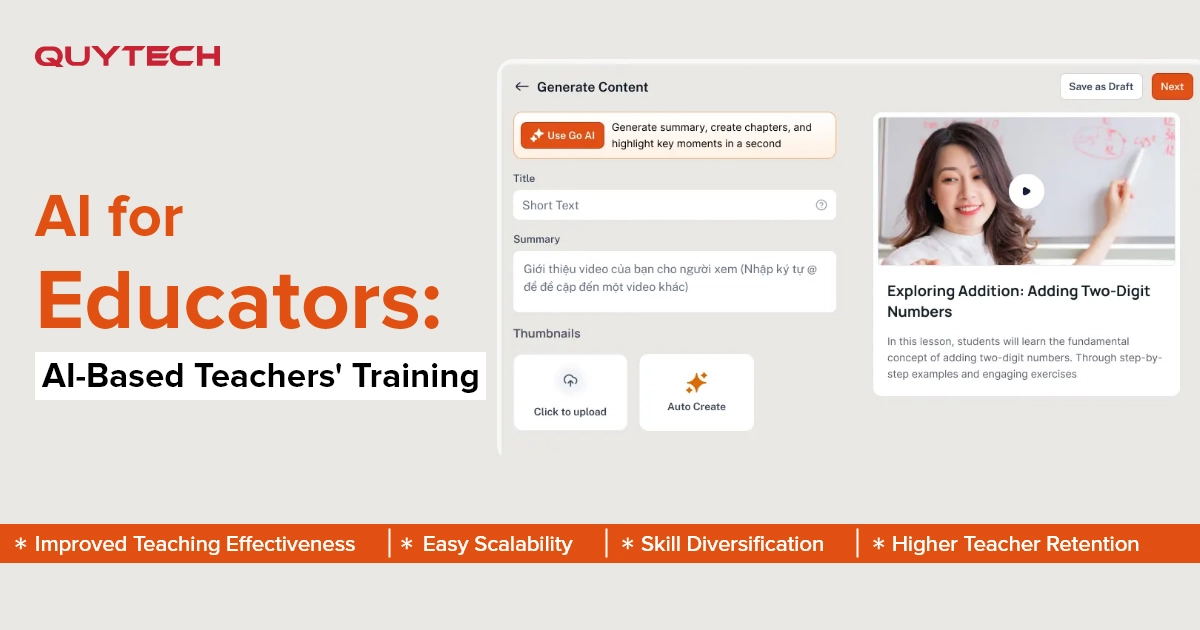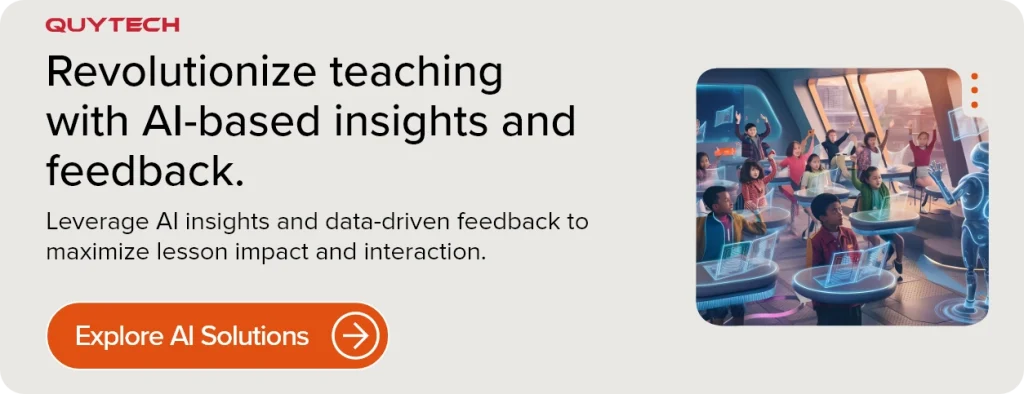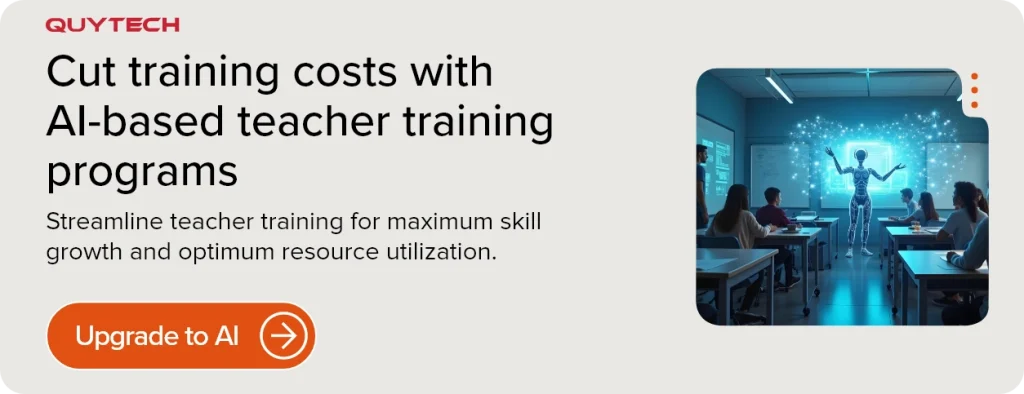Teachers are the backbone of the education sector, and just like any other field, teaching also requires continuous refinement and adaptation. This is something that not only enhances the teaching methods but also helps in improving lesson delivery.
In the traditional setting, teacher training is conducted as a generic program for all teachers. It doesn’t focus on enhancing specific skills for every individual. Instead, it follows a one-size-fits-all approach. This makes training procedures ineffective and also wastes resources.
To tackle this, AI comes into play. AI-based teachers’ training doesn’t train in groups. Instead, it creates personalized training plans for every individual. It counts the strong points, weaknesses, and opportunities separately for each educator. Based on the outcomes, it creates training plans, follow-ups, assessments, and much more.
This blog will walk you through the transition that AI-based teachers’ training has brought in. It highlights how AI is reshaping conventional methods, addressing long-standing gaps, and empowering educators.
Key Takeaways:
- AI-based teachers’ training spots skill gaps, personalizes action plans, and tracks progress.
- It adapts to classrooms’ needs, creates training plans, takes follow-up, and ensures continuous growth.
- AI collects data, profiles teachers, personalizes training, tracks progress, and provides insights.
- AI training boosts teacher skills, retention, scalability, and student learning experience.
- Its implementation issues include ethical & data risks, change resistance, and tech gaps.
- Future trends include predicting skills gaps, following global trends, and assisting teachers.
Understanding AI-Based Teachers’ Training
AI-based teachers’ training does way more than creating teaching programs. Like any other profession, teaching also requires teachers to hone their skills. To facilitate this, educational institutions offer programs for skill set enhancement. The difference that AI makes here is that it does not go for generic training sessions. It provides personalized ones.
AI analyzes the current teaching practices that teachers employ during lectures. After analysis, it compares the performance to find gaps like clarity in lesson delivery, lack of interactions, etc. Based on these gaps, AI creates action plans for teachers to work on. It does not stop here; AI takes follow-up actions to track progress. This is how AI plays its role in training educators.
Why Traditional Teacher Training Doesn’t Work Anymore
The times have changed drastically; the teacher training programs that once worked fail to be effective today. The reasons behind these are the generic training plans. These plans fail to address the weak points of each teacher. Instead, they target common issues and focus on solving them.
Even the assessment of teachers is done based on generic parameters, and training programs also follow the one-size-fits-all approach. Let’s get a deeper understanding of these problems and uncover why traditional teacher training programs fall short today:
Outdated Teaching Methods
The need for AI in teacher training rises as classroom needs evolve. Every student is different, with different learning speeds, styles, and special needs. Along with these, the introduction of digital tools and smart classrooms is also a concern that the traditional teaching methods fail to address. AI helps teachers in keeping up with it by assessing teaching methodology and offering recommendations for improvement.
Generic Training Plans
In a conventional teaching setting, teachers get one generic training plan that vaguely covers everything. The minus point here is that, similar to students, teachers are also different and have different ways of teaching. Unlike generic plans, which fail to target the weak points of every teacher, AI assesses the weaknesses and offers training plans accordingly.
Ineffective Follow-Up Plans
Unlike conventional teacher training, which requires yearly follow-ups, AI conducts follow-ups in real-time. It tracks the progress of educators and analyzes improvements and areas that need to be improved. This helps teachers hone their skills.
Lack of Professional Growth
The need for AI grows as educators require not only teaching support but also continuous professional development. AI-powered teachers’ training offers continuous professional growth opportunities by optimizing training plans based on teachers’ strengths and weaknesses.
Similar Read: AI in Customer Journey Mapping: Insights and Impact
How AI-Based Teachers’ Training Works
The working mechanism of AI-based teachers’ training is quite simple to understand. Here’s a step-by-step breakdown of how AI-based teachers’ training works:
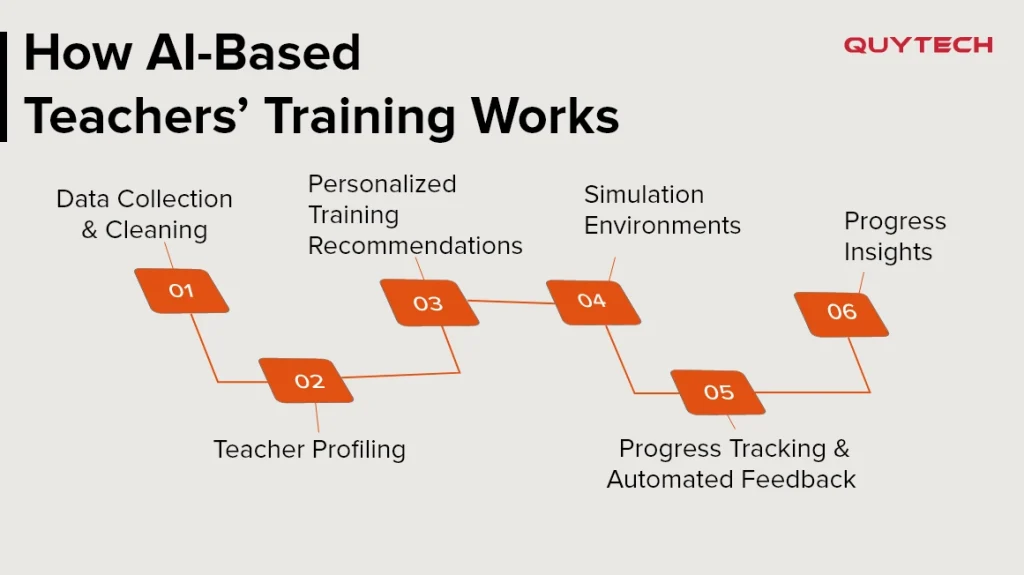
Data Collection and Cleaning
Firstly, the AI systems collect all the data of teachers. This includes the lesson plans, self-reports, historical, as well as real-time classroom data. The data is collected through IoT devices and computer vision pipelines. This data is then cleaned, processed, and analyzed.
Teacher Profiling
After cleaning and analyzing data, the AI-based training system creates teacher profiles. This profile is where each teacher’s details, reports, progress, and user dashboards are. From here, the teachers can submit reports, assess their performance scores, and also access their training plans.
Personalized Training Recommendations
Post teacher profiling, AI systems analyze data to assess the strong points, weak points, and growth opportunities. Based on this analysis, advanced AI technologies like machine learning and NLP models create personalized training plans.
Simulation Environments
Along with the training programs, simulation practices are also offered to train teachers on dealing with classroom environments effectively. To facilitate this training, virtual reality and conversational AI models are utilized.
Progress Tracking and Automated Feedback
AI doesn’t stop at training programs; it goes above and beyond to track the progress of teachers. It does so to analyze the effectiveness of training programs. Also, AI tracks this progress and offers feedback. Machine learning, computer vision, and natural language processing contribute to this step.
Progress Insights
After tracking progress and providing feedback, AI aggregates the performance of every teacher to provide institutional insights. This helps the institutions in understanding their employees, their strong and weak points, and allocate resources effectively. AI enables continuous improvement for institutions, educators, and students.
You Might Also Like: AI in Employee Performance Analysis and Skill Development
Benefits of AI-driven Training for Teachers and Institutions
Now that you are familiar with how AI-based teachers’ training works, let’s guide you through the benefits that it offers:
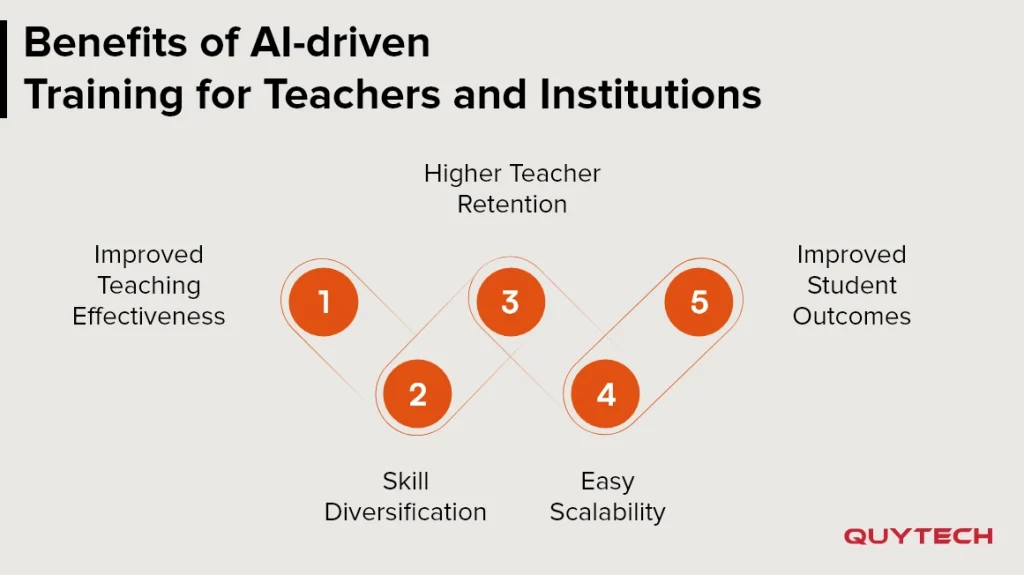
Improved Teaching Effectiveness
AI-based teachers’ training multiplies the teaching effectiveness. It analyzes the areas where teachers are lacking and offers training accordingly. This improves the lacking areas and enhances the teaching effectiveness automatically.
Skill Diversification
AI for teacher training is capable of identifying weak points that even the teachers themselves might not be aware of. This helps them in improving not just classroom skills but additional ones as well, contributing to overall career development.
Higher Teacher Retention
Utilizing AI for teacher training is beneficial not just for the teachers but also for the institutions. It helps in improving employee retention as it offers the educators opportunities to not just work but also bring improvements in their methods. This ensures that both the teachers and the institution grow together.
Easy Scalability
Scalability is yet another benefit of utilizing AI-based teachers’ training. It ensures that the educational institutions do not need to invest in multiple training plans. AI is capable of analyzing the data of multiple teachers and offering growth opportunities even if the number of employees increases.
Improved Student Outcomes
AI-based teachers’ training enhances not just teachers’ teaching skills but also the learning experience of students. When the teaching methodology of educators is refined, it helps students understand concepts better.
Read More: AI-Powered Real-Time Sports Analytics
AI-Based Teachers’ Training: Challenges and Considerations
Introducing artificial intelligence comes with much more than fancy tech advancements. It brings in equal responsibility, challenges, and considerations. Here are some of them:
Ethical Use of AI
A prominent consideration is ensuring ethical use when employing AI in teachers’ training. Many times, AI might unknowingly create or follow biases when assessing teachers’ performance. This can result in inaccurate outputs and action plans. To avoid this, educators should ensure that they don’t depend too much on AI, view it as a means to improve instead of a shortcut.
Data Concerns
Since AI works on sensitive data, it’s very obvious that data concerns may arise in the minds of educators and institutions. To ensure that data is well protected, educational institutions can follow data protection practices like encryption and regulatory compliance.
Resistance to Change
When introducing AI in teacher training, institutions may face resistance to change from teachers. This is usually because of a lack of awareness and proper training. To ensure that institutions do not face these challenges, they should offer training programs for teachers. This will help educators understand that AI is there as an assistant and not as a replacement.
Compatibility Issues
Implementing AI-based teachers’ training can be challenging if the institutions lack appropriate infrastructure. This includes a strong internet connection, sophisticated devices, and technical support. At times, the AI can also fail to integrate with existing systems due to their outdated technology. To ensure smooth integration, institutions should consider upgrading their existing systems.
Similar Read: AI-Powered Talent Acquisition for Enterprises: Using AI for Smart Recruitment
How Institutions Can Implement AI-Based Training
Adopting AI-based teachers’ training requires much more than just technology. It requires prompt planning, strategies, resources, execution, and follow-up. Here’s a breakdown of the steps for implementing AI for teacher training:
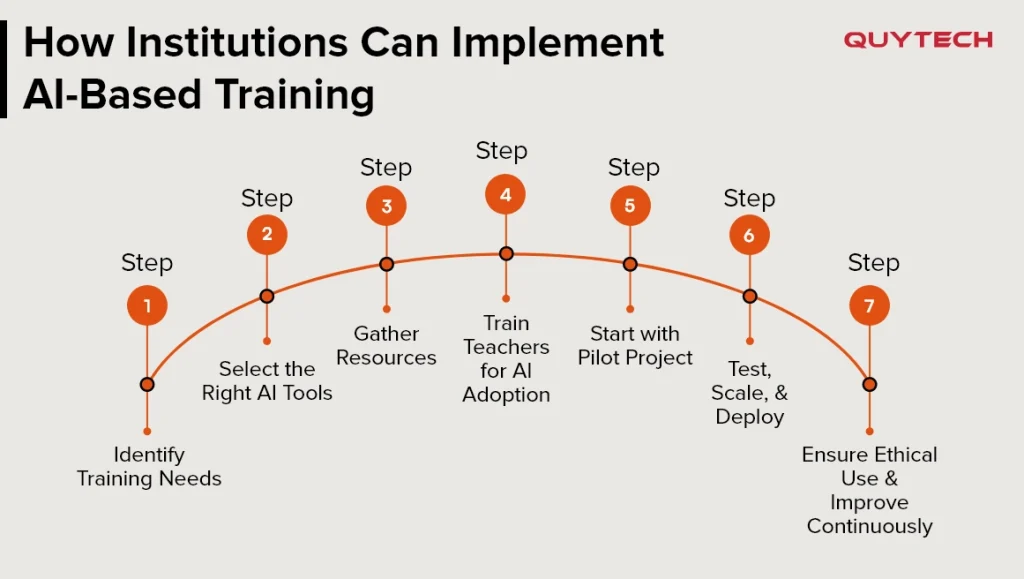
Step 1: Identify Training Needs
Identify the areas where you feel AI needs to be implemented. This includes the gaps in teacher skills and current training programs. In this step, you will create a track to follow.
Step 2: Select the Right AI Tools
After identifying training needs, start selecting the right AI tools for your use cases. These include personalized learning platforms, VR simulation-based training, feedback systems, etc. Ensure that you consider scalability and compatibility in mind while choosing the tools.
Step 3: Gather Resources
After selecting the right AI tools, start gathering the resources that would contribute to and support your AI-based teachers’ training system. This involves gathering devices, ensuring a strong internet connection, and integrating with existing systems.
Step 4: Train Teachers for AI Adoption
Once the resources are gathered, ensure that your human resources and technologies are in harmony. This is done by training the educators to understand how AI works and how it will assist them. You can do this by conducting workshops and training programs.
Step 5: Start with Pilot Project
Post-training, start working on your AI systems. Start with a pilot project. This supports easy testing and fine-tuning. If the same is done on the original project, it could lead to wastage of resources.
Step 6: Test, Scale, and Deploy
After building the pilot project, start testing it. Thorough testing will catch bugs that can be improved before deploying the system. Scale the systems once they pass the quality checks. Deploy and monitor their performance to ensure smooth working.
Step 7: Ensure Ethical Use and Improve Continuously
Ensure that your AI-based teachers’ training systems comply with the ethical AI and data regulations. Continuously monitor, introduce new features, and improve the systems post-deployment.
You Might Also Like: How to Build an AI Interview Bot: A Comprehensive Guide
Future of AI in Teacher Training
AI-based teachers’ training is not just a trend of the current day but also a step towards the future of teacher education. Artificial intelligence will not stop here; instead, it will keep growing in the future. There will be much more to watch than what is being served currently. Here’s a glance at the future trends of AI for teacher training:
Predictive Skill Development
The future holds predictive skill development for AI-based teachers’ training. AI will go beyond the current-day skill gap analysis with the help of predictive analytics. It will predict possible future skill gaps and offer action plans to cater to them proactively.
Integration with Global Educational Trends
The AI-powered teachers’ training systems will align with global educational trends. This will be supported by advanced machine learning models, NLP, and data analytics. Recommendation engines will also contribute to this trend.
Collaborative AI Support
In the future, AI will not just assist with action plans. It will ease the burden of educators by automating tasks like lesson planning, grading, and related teaching assistance. AI will deliver insights that help educators make better decisions for effective classroom management.
Conclusion
As the education sector evolves rapidly, teachers must stay equipped to keep pace with these changes. And to facilitate the same, AI-based teachers’ training comes into play. It collects classroom data, analyzes teaching methods, finds skill gaps, and offers personalized action plans.
AI for teacher training brings in benefits like improved teaching efficiency, skill diversification, teacher retention, easy scalability, and better student outcomes. All these benefits reflect how AI transforms teacher training methods, making it a worthwhile investment.
FAQs
The implementation of AI-based teachers’ training can take several months. The duration depends on complexity, scalability, and integration factors.
No, teachers will not require extensive training to use the AI platform effectively. For a user-friendly solution, basic training does the job.
Yes, AI-based teachers’ training systems utilize data and technology, so there are data and ethical AI-related compliance requirements.
Not necessarily, you do not need a technical team to implement AI for teacher training. You can implement AI by either hiring developers or collaborating with an AI development company.
